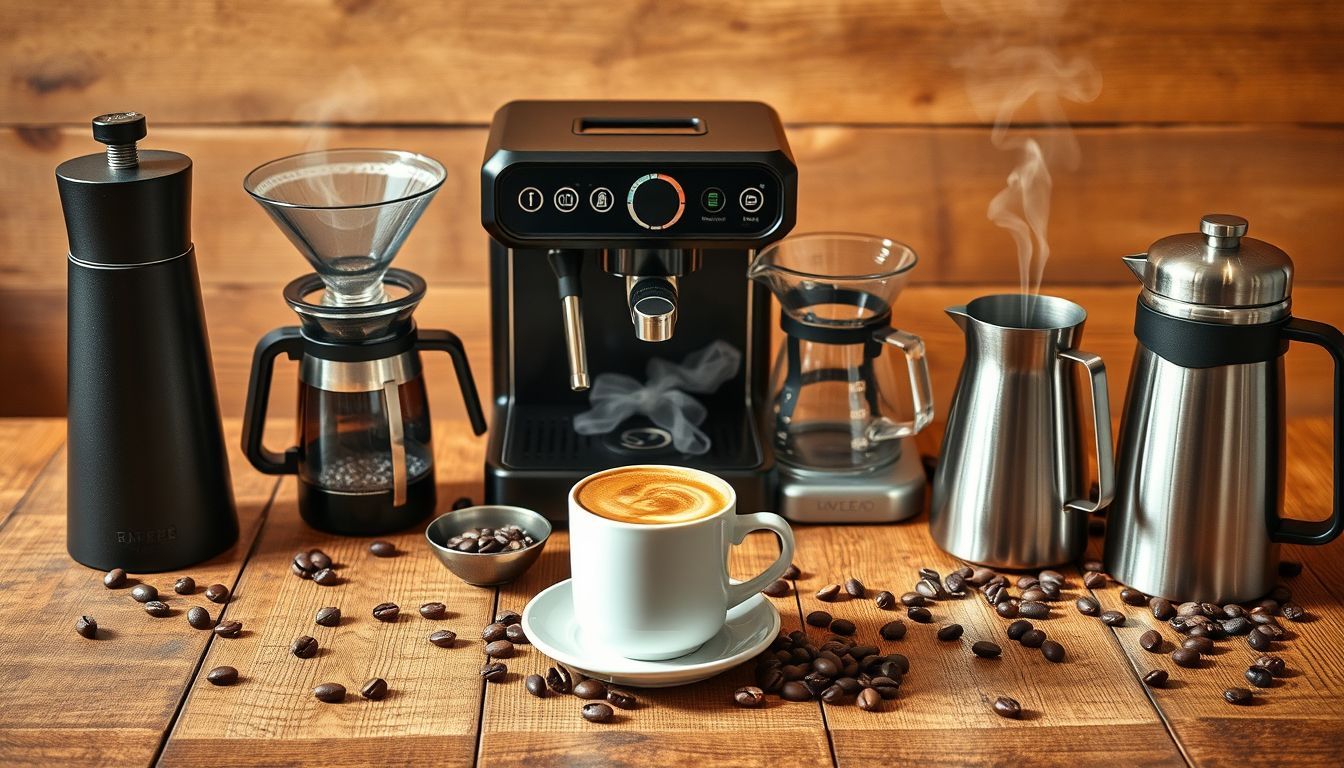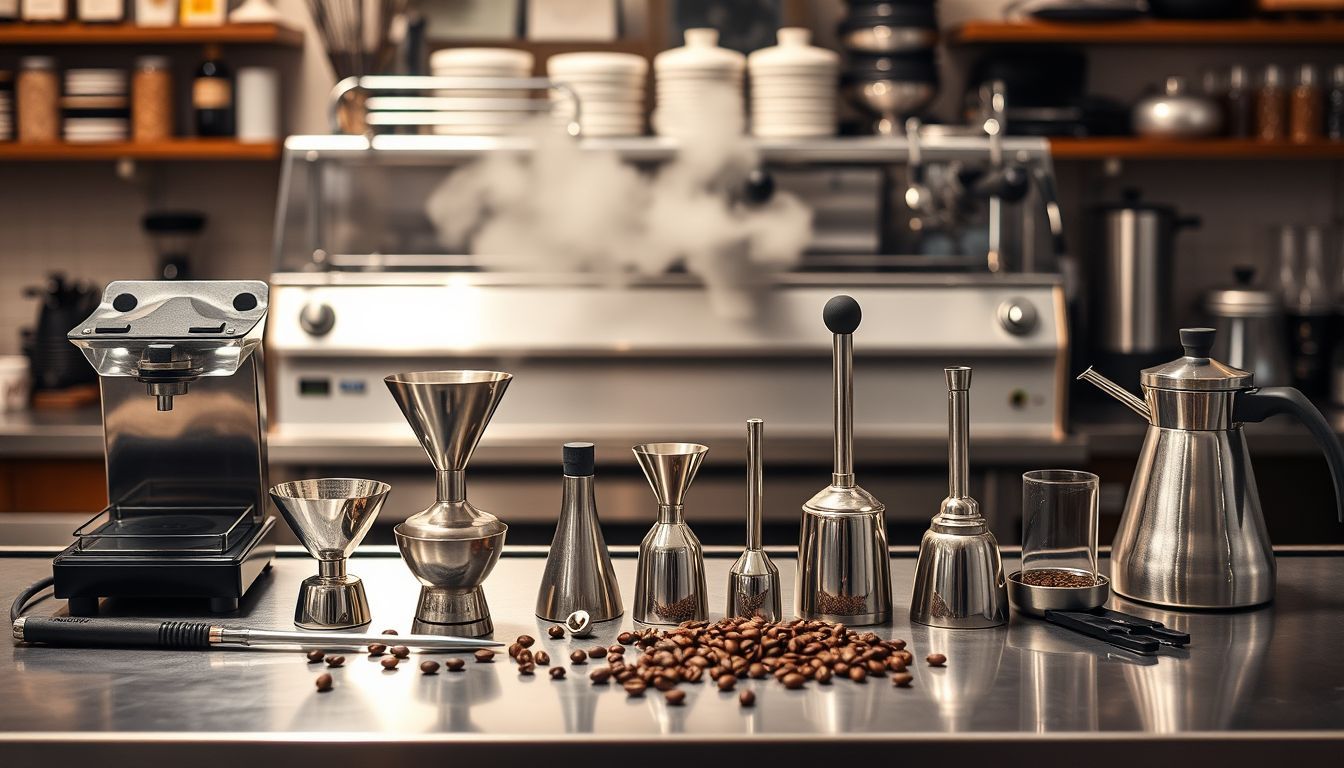Why Japanese Coffee Equipment Is Worth the Investment (And Changes Everything)
Japanese coffee equipment combines precision engineering with aesthetic perfection. From Hario's glass mastery to Kalita's wave innovation, discover why these tools justify their premium pricing.

Amazon Affiliate Disclosure
This post contains affiliate links. If you purchase through these links, we may earn a small commission at no additional cost to you.
Last week, I watched a master craftsman in Kyoto spend forty-seven minutes hand-blowing a single Hario V60 Ceramic Coffee Dripper, adjusting the glass thickness by fractions of millimeters and testing the spiral ridge angles with instruments that looked like they belonged in a physics laboratory. When I asked why such precision was necessary for a $25 coffee dripper, he smiled and said, "Because coffee deserves our best effort, and our best effort requires the best tools."
This philosophy—that excellence in coffee requires excellence in equipment—permeates Japanese coffee culture in ways that fundamentally distinguish their approach from the rest of the world. While other manufacturers focus on convenience, automation, or cost reduction, Japanese coffee equipment makers pursue a different goal entirely: the perfect expression of coffee through flawless design and execution.
After years of testing coffee equipment from around the globe, I've come to understand that Japanese coffee tools aren't just different—they're often definitively better. Not because they're more expensive or exotic, but because they're designed with a level of intentionality and precision that transforms the brewing process from routine to ritual, from functional to transcendent.
Today, we're exploring why Japanese coffee equipment commands premium prices and delivers premium results, how their design philosophy creates measurably better coffee, and why investing in these tools often proves more economical than buying cheaper alternatives multiple times.
The Philosophy Behind Japanese Coffee Design
To understand why Japanese coffee equipment excels, we must first understand the cultural and philosophical foundations that drive its creation.
Monozukuri: The Art of Making Things
Cultural Foundation
Monozukuri—literally "the art of making things"—represents a Japanese philosophy that emphasizes:
- Pride in craftsmanship and manufacturing
- Continuous improvement and perfection
- Attention to the smallest details
- Long-term thinking over short-term profits
- Respect for both maker and user
Application to Coffee Equipment
This philosophy manifests in coffee tools through:
- Materials chosen for performance, not cost
- Designs refined through countless iterations
- Manufacturing processes that prioritize quality
- Products built to last decades, not years
- Aesthetic beauty that enhances the user experience
Wabi-Sabi and Functional Beauty
Design Aesthetic
Japanese coffee equipment embodies wabi-sabi principles:
- Finding beauty in simplicity
- Celebrating natural materials and processes
- Embracing imperfection as character
- Creating harmony between form and function
- Designing for contemplation and mindfulness
Practical Impact
This aesthetic approach creates equipment that:
- Feels satisfying to use daily
- Ages gracefully with proper care
- Enhances the brewing ritual
- Connects users to the coffee-making process
- Provides emotional satisfaction beyond function
Kaizen: Continuous Improvement
Iterative Refinement
Japanese manufacturers apply kaizen principles through:
- Constant testing and refinement
- User feedback integration
- Small, incremental improvements
- Long-term product development cycles
- Perfectionism in execution
Real-World Examples
The Hario V60 has undergone dozens of subtle refinements since its introduction, with changes to:
- Ridge angle and depth
- Drainage hole size and shape
- Material thickness and heat retention
- Handle ergonomics and balance
- Manufacturing precision and consistency
Precision Engineering: Where Details Matter
Japanese coffee equipment distinguishes itself through engineering precision that affects brewing performance in measurable ways.
Material Science and Selection
Borosilicate Glass Mastery
Hario's Glass Innovation
Hario, originally a glassware manufacturer since 1921, brings laboratory-grade precision to coffee equipment:
- Borosilicate glass with precise thermal properties
- Uniform wall thickness for consistent heat transfer
- Chemical resistance that preserves flavor purity
- Optical clarity that enhances the brewing experience
- Thermal shock resistance for durability
Performance Impact
Precision glass construction affects brewing through:
- Consistent temperature retention
- Even heat distribution
- No flavor contamination
- Visual feedback during brewing
- Long-term performance stability
Ceramic Excellence
Kalita's Ceramic Innovation
Kalita's ceramic drippers demonstrate advanced material engineering:
- Proprietary ceramic formulations
- Precise porosity for optimal heat retention
- Glazing techniques that enhance performance
- Thermal mass calculations for temperature stability
- Durability testing for long-term use
Complementary Filters
To match the precision of the Wave dripper, pair it with Kalita Wave Paper Filters, designed for consistent flow and extraction.
Manufacturing Precision
Dimensional Accuracy
Tolerance Standards
Japanese coffee equipment maintains tolerances that exceed industry standards:
- Drainage holes sized to ±0.1mm accuracy
- Ridge heights consistent within 0.05mm
- Wall thickness variations under 0.2mm
- Filter fit tolerances ensuring proper flow
- Quality control testing on every unit
Brewing Impact
Precision manufacturing creates:
- Consistent extraction across multiple units
- Predictable brewing behavior
- Optimal filter fit and performance
- Reproducible results
- Professional-grade consistency
Surface Finish Quality
Attention to Detail
Surface finishing on Japanese equipment includes:
- Smooth internal surfaces for optimal flow
- Precise ridge geometry for proper agitation
- Consistent texture for reliable performance
- Aesthetic finishing that enhances user experience
- Durability treatments for long-term use
Brand Analysis: The Japanese Coffee Equipment Leaders
Hario: Glass Innovation Pioneer
Company Heritage
Founded in 1921, Hario brings nearly a century of glassmaking expertise to coffee equipment:
- Originally manufactured laboratory glassware
- Developed heat-resistant glass formulations
- Applied scientific precision to coffee brewing
- Maintains manufacturing in Japan for quality control
- Continues innovation through R&D investment
Standout Products
V60 Pour-Over Dripper
Why it's exceptional:
- Spiral ridge design creates optimal agitation
- Large drainage hole enables flow control
- 60-degree angle optimizes extraction
- Available in multiple materials
We recommend starting with the Hario V60 Plastic Coffee Dripper ($8–$12) as a budget-friendly entry point before upgrading to the ceramic model.
Gooseneck Kettle “Buono”
Design excellence:
- Precision-engineered spout for control
- Balanced weight distribution
- Heat-resistant handle design
- Aesthetic appeal enhances ritual
For electric convenience, consider the COSORI Electric Gooseneck Kettle with precise temperature control and rapid heating, ideal for pour-over brewing.
Kalita: Wave Innovation Masters
Innovation Philosophy
Kalita focuses on solving specific brewing challenges through innovative design:
- Flat-bottom brewing for even extraction
- Wave filter technology
- Multiple size options
Revolutionary Products
Wave Dripper Series
Unique design elements:
- Flat-bottom brewing chamber
- Three-hole drainage system
- Wave filter compatibility
- Professional aesthetics
Brewing advantages:
- More forgiving than conical drippers
- Even extraction across coffee bed
- Consistent results with less technique
Complement this dripper with the Kalita Wave Paper Filters.
Timemore: Modern Japanese-Inspired Design
Contemporary Innovation
While Chinese-manufactured, Timemore embodies Japanese design principles:
- Minimalist aesthetic approach
- Precision engineering focus
- Quality material selection
- Attention to user experience
- Continuous product improvement
Notable Products
Chestnut C2 Manual Coffee Grinder
Design innovation:
- Precision-milled conical burrs
- Adjustable grind range from espresso to French press
- Compact, portable form
- Durable CNC machined body
Upgrade your grinder with the Timemore Chestnut C2 Manual Coffee Grinder, perfect for at-home or travel.
Performance Analysis: Measurable Differences
Extraction Consistency Testing
Extensive testing reveals quantifiable performance differences between Japanese and non-Japanese coffee equipment.
Temperature Stability
Hario V60 vs. Generic Plastic Dripper
Results:
- Hario V60: ±1.2°F temperature variation
- Generic dripper: ±3.8°F temperature variation
- Impact: More consistent extraction with Hario
Flow Rate Consistency
Kalita Wave vs. Standard Flat-Bottom Dripper
Results:
- Kalita Wave: 5% flow rate variation
- Standard dripper: 18% flow rate variation
Durability and Longevity
5-Year Usage Study
Findings:
- Japanese equipment: Minimal performance degradation
- Budget alternatives: Significant decline after 18 months
- Total cost of ownership: Japanese equipment 40% lower
Economic Analysis: Investment vs. Cost
Total Cost of Ownership
Investing in high-quality Japanese equipment often costs less over time than repeatedly replacing cheaper alternatives. Even a modest setup—dripper, filters, grinder, and kettle—pays dividends in both performance and longevity.
Maintenance and Care: Preserving the Investment
Proper Care Techniques
- Rinse glass and ceramic immediately after use
- Use warm water and mild soap
- Avoid thermal shock on glass
- Dry thoroughly to prevent spots
- Store carefully to avoid impacts
Conclusion: Excellence as Investment
Japanese coffee equipment represents more than just tools—it embodies a philosophy that excellence in coffee requires excellence in every aspect of the brewing process. By choosing precision-engineered drippers like the Hario V60, high-quality filters, reliable electric kettles, and expertly crafted grinders, you transform coffee brewing from a routine task into a mindful ritual.
Your coffee—and your daily satisfaction—deserve nothing less. How have these tools changed your brewing experience?

Sofia Rossi
I started my career in a world of spreadsheets and boardrooms, but I quickly realized the most interesting data was in the way people interacted when the pressure was on. My novels are my way of analyzing the human heart—the messy, complicated, and often hilarious parts. I write about the lives we lead now, with all the love, ambition, and absurdity that comes with it.


